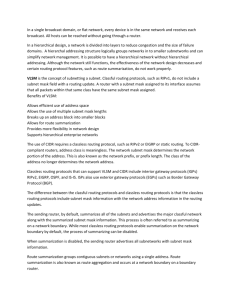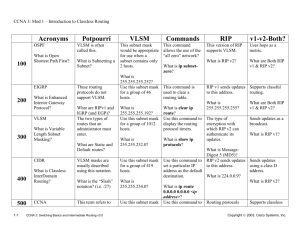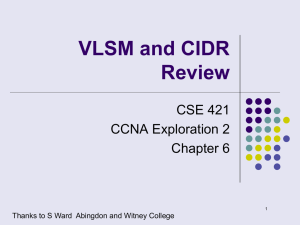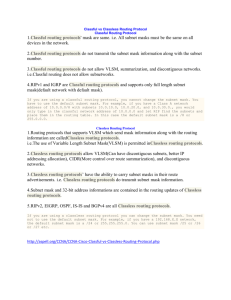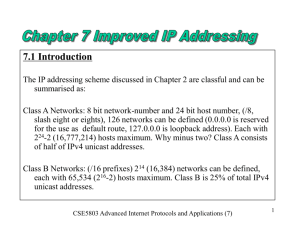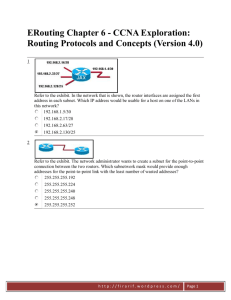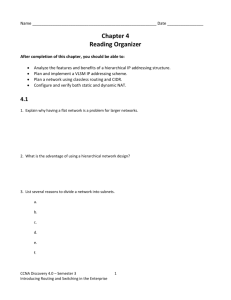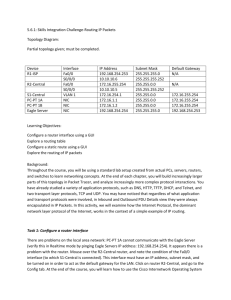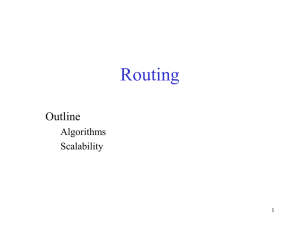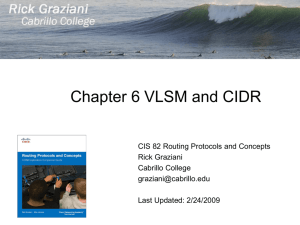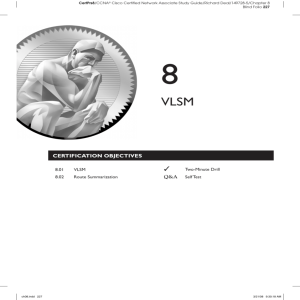Addressing in an Enterprise Network
advertisement
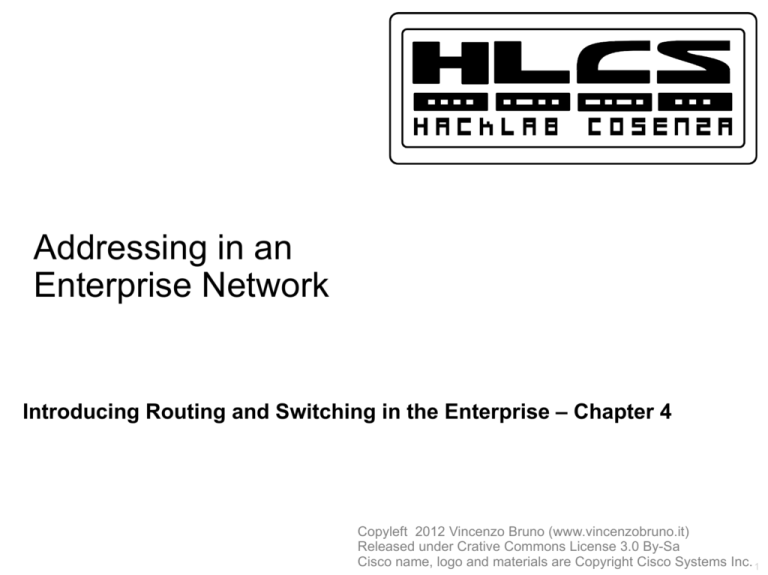
Addressing in an Enterprise Network Introducing Routing and Switching in the Enterprise – Chapter 4 Copyleft 2012 Vincenzo Bruno (www.vincenzobruno.it) Released under Crative Commons License 3.0 By-Sa Cisco name, logo and materials are Copyright Cisco Systems Inc. 1 Overview Hierarchical network design ● ● A hierarchical addressing structure logically groups networks into smaller subnetworks A hierarchical network design and address structure simplifies network management and troubleshooting and also improves scalability and routing performance. Subnet mask ● ● ● ● ● ● The subnet mask indicates whether hosts are in the same network. The subnet mask is a 32-bit value that distinguishes between the network bits and the host bits. It consists of a string of 1s followed by a string of 0s. The 1 bits represent the network portion and the 0 bits represent the host portion. In an enterprise network, subnet masks vary in length. LAN segments often contain varying numbers of hosts; therefore, it is not efficient to have the same subnet mask length for all subnets created. List of subnet Masks Summarization Example Network → Third Octet 10.10.200.0 → 11001000 10.10.201.0 → 11001001 10.10.202.0 → 11001010 10.10.203.0 → 11001011 AND operation results in: 10.10.200.0 → 11001000 Subnet mask → 11111100 → /22 (XNOR operation) Excercise on networks Variable Length Subnet Masks ● VLSM is the concept of subnetting a subnet ● VLSM provide for efficient use of address space. ● ● It also allows for hierarchal IP addressing which allows routers to take advantage of route summarization. Route summarization reduces the size of routing tables in distribution and core routers. ● Smaller routing tables require less CPU time for routing lookups. ● Not all routing protocols support VLSM: ● ● Classful routing protocols, such as RIPv1, do not include a subnet mask field with a routing update. A router with a subnet mask assigned to its interface assumes that all packets within that same class have the same subnet mask assigned. VLSM benefits ● Classless routing protocols support the use of VLSM because the subnet mask is sent with all routing update packets. ● Classless routing protocols include RIPv2, EIGRP, and OSPF. ● Benefits of VLSM: ● Allows efficient use of address space ● Allows the use of multiple subnet mask lengths ● Breaks up an address block into smaller blocks ● Allows for route summarization ● Provides more flexibility in network design ● Supports hierarchical enterprise networks VLSM example Classless Inter-Domain Routing ● ● ● ● With the rapid depletion of IPv4 addresses, the Internet Engineering Task Force (IETF) developed Classless InterDomain Routing (CIDR). CIDR uses IPv4 address space more efficiently and for network address aggregation or summarizing, which reduces the size of routing tables. The use of CIDR requires a classless routing protocol, such as RIPv2 or EIGRP or static routing With CIDR and VLSM, ISPs are no longer limited to using prefix lengths of /8, /16 or /24. Classless routing ● If the router sends an update about a subnetted network, such as 172.16.1.0/24, to a router whose connecting interface is in a different major network, such as 192.168.1.0/24 then: ● ● ● ● The sending router, by default, summarizes all of the subnets and advertises the major classful network along with the summarized subnet mask information. This process is often referred to as summarizing on a network boundary. While most classless routing protocols enable summarization on the network boundary by default, the process of summarizing can be disabled. When summarization is disabled, the sending router advertises all subnetworks with subnet mask information. Route summarization ● ● ● ● ● ● A VLSM addressing scheme allows for route summarization, which reduces the number of routes advertised. Route summarization groups contiguous subnets or networks using a single address. Route summarization is also known as route aggregation and occurs at a network boundary on a boundary router. Route summarization is synonymous with the term supernetting. Supernetting joins multiple smaller contiguous networks together. It is easier to perform summarization if the addressing scheme is hierarchical Find the summarization Discontiguous networks Discontiguous networks ● Discontiguous networks cause unreliable or suboptimal routing. To avoid this condition, an administrator can: ● Modify the addressing scheme, if possible ● Use a classless routing protocol, such as RIPv2 or OSPF ● Turn automatic summarization off ● Manually summarize at the classful boundary Private addresses ● ● ● Private addresses are available for anyone to use in their enterprise networks because private addresses route internally, they never appear on the Internet. RFC 1918 governs the use of the private address spacing. ● Class A: 10.0.0.0 - 10.255.255.255 ● Class B: 172.16.0.0 - 172.31.255.255 ● Class C: 192.168.0.0 - 192.168.255.255 Using private addressing has these benefits: ● ● ● It alleviates the high cost associated with the purchase of public addresses for each host. It allows thousands of internal employees to use a few public addresses. It provides a level of security, because users from other networks or organizations cannot see the internal addresses. Network Address Translation ● ● NAT translates internal private addresses into one or more public addresses for routing onto the Internet. Benefits: ● ● ● Small to medium organizations connect to their ISPs through a single public address Using NAT on boundary routers improves security Most routers that implement NAT block packets coming from outside the private network unless they are a response to a request from an inside host Static and dynamic NAT ● ● ● ● ● ● Static NAT maps a single inside local address to a single global, or public address called the inside global address. This mapping ensures that a particular inside local address always associates with the same public address. Static NAT ensures that outside devices consistently reach an internal device Dynamic NAT uses an available pool of Internet public addresses and assigns them to inside local addresses. Dynamic NAT assigns the first available IP address in the pool of public addresses to an inside device. The NAT router manages the translations between the inside local addresses and the inside global addresses by maintaining a table that lists each address pair. Configure static NAT Configure dynamic NAT Port Address Translation ● ● ● ● ● One of the more popular variations of dynamic NAT is known as Port Address Translation (PAT), also referred to as NAT Overload. PAT dynamically translates multiple inside local addresses to a single public address. In PAT, the gateway router translates the local source address and port number combination to a single global IP address and a unique port number above 1024 A table in the router contains a list of the internal IP address and port number combinations that are translated to the external address. Although each host translates into the same global IP address, the port number associated with the conversation is unique. Configure PAT Verifying PAT End of lesson
